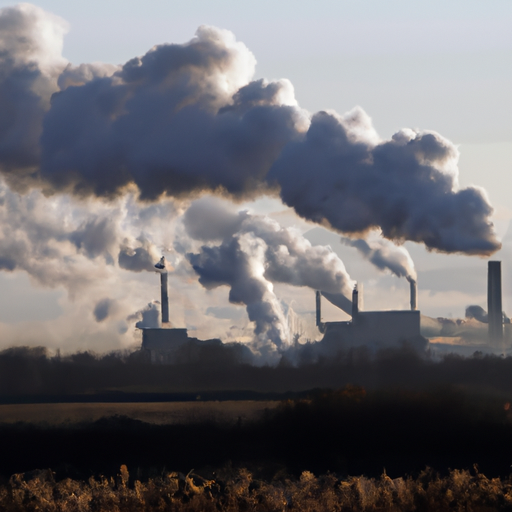
Headings for an article focused on environmental pollution:
Environmental pollution is a pressing issue that affects our planet on a global scale. It refers to the contamination of the environment by various sources, such as pollutants released from industrial processes, improper waste disposal, deforestation, and the burning of fossil fuels. The impact of environmental pollution is far-reaching and has detrimental effects on human health, biodiversity, and the overall well-being of the planet.
Understanding the different aspects of environmental pollution is crucial in order to address and mitigate its effects. In this article, we will explore some key headings that shed light on different facets of environmental pollution:
1. Sources of Environmental Pollution
One of the first steps in tackling environmental pollution is identifying its sources. This heading will delve into the different activities and processes that contribute to pollution, such as industrial emissions, vehicle exhaust, agricultural practices, and improper waste management.
2. Impact on Human Health
Environmental pollution poses significant risks to human health. This heading will discuss how air, water, and soil pollution can lead to various health issues, including respiratory problems, cardiovascular diseases, neurological disorders, and even certain types of cancer. It will also explore the vulnerable populations that are most affected by pollution, such as children, pregnant women, and the elderly.
3. Effects on Biodiversity
The pollution of natural habitats and ecosystems has a profound impact on biodiversity. This heading will highlight how pollution disrupts delicate ecological balances, leading to the decline and extinction of plant and animal species. It will also discuss the indirect effects of pollution on the food chain and the loss of valuable ecosystem services.
4. Climate Change and Pollution
Environmental pollution and climate change are closely intertwined. This heading will explore the link between greenhouse gas emissions, global warming, and pollution. It will discuss how the burning of fossil fuels contributes to both air pollution and the intensification of climate change, leading to more frequent and severe weather events, rising sea levels, and other environmental disruptions.
5. Solutions and Mitigation Measures
Addressing environmental pollution requires collective action and commitment. This heading will outline potential solutions and mitigation measures that can help reduce pollution levels and prevent further damage to the environment. It will cover areas such as renewable energy adoption, sustainable waste management, reforestation efforts, and the importance of policy changes and international cooperation.
By exploring these headings, we can deepen our understanding of environmental pollution and take meaningful steps towards a cleaner and healthier planet.
Introduction: Understanding the Global Environmental Pollution Crisis
The global environmental pollution crisis has become one of the most pressing issues of our time. With increasing levels of pollution, our planet is facing numerous challenges that threaten the well-being of all living beings. Understanding the root causes and consequences of this crisis is essential in developing effective solutions to tackle it.
One of the key aspects of the environmental pollution crisis is the impact on human health. Pollution, whether it is air, water, or soil pollution, has been linked to various health problems, including respiratory diseases, cardiovascular issues, and even cancer. The pollutants released into the environment by industries, transportation systems, and other human activities are toxic and can have long-term effects on our health.
Another aspect that needs to be addressed is the impact of pollution on biodiversity. The release of harmful chemicals and pollutants into the ecosystems has led to the disruption of natural habitats and the loss of biodiversity. Species extinction rates are increasing at an alarming rate, and the delicate balance of ecosystems is being severely disrupted. This loss of biodiversity not only affects the natural world but also has serious implications for human societies, as we depend on the services that ecosystems provide, such as clean air, water, and food.
Furthermore, the global environmental pollution crisis is closely tied to climate change. Pollution, particularly greenhouse gas emissions, are major contributors to global warming and its associated environmental changes. The burning of fossil fuels, deforestation, and industrial activities release large amounts of carbon dioxide and other greenhouse gases into the atmosphere, leading to rising temperatures, melting ice caps, and extreme weather events.
To address this crisis, international cooperation and comprehensive policies are urgently needed. Governments, industries, and individuals all have a role to play in reducing pollution and implementing sustainable practices. This includes investing in renewable energy sources, adopting cleaner technologies, and promoting recycling and waste management.
In conclusion, understanding the global environmental pollution crisis requires examining its various aspects, including the impact on human health, biodiversity, and climate change. It is crucial to take immediate action to mitigate the effects of pollution and work towards a cleaner, healthier planet for future generations.
Types of Environmental Pollution and Their Impact
Environmental pollution is a major concern that affects our planet and the well-being of all living beings. It refers to the contamination of the natural environment by various pollutants, resulting in adverse effects on the ecosystems and human health. There are several types of environmental pollution, each posing unique challenges and consequences.
Air Pollution
Air pollution is one of the most prevalent forms of environmental pollution. It occurs when harmful substances, such as particulate matter, gases, and chemicals, are released into the air. Sources of air pollution include industrial emissions, vehicle exhaust, tobacco smoke, and burning of fossil fuels. These pollutants can lead to respiratory problems, cardiovascular diseases, and even premature death. Furthermore, air pollution also contributes to climate change by promoting the greenhouse effect.
Water Pollution
Water pollution happens when harmful substances enter water bodies, such as lakes, rivers, and oceans. Common sources of water pollution include industrial waste discharge, agricultural runoff, sewage, and improper disposal of chemicals. Water pollution can have severe impacts on aquatic life, affecting their survival and reproduction. Additionally, contaminated water poses a significant risk to human health, as it can lead to waterborne diseases and infections.
Soil Pollution
Soil pollution occurs when the soil becomes contaminated with toxic chemicals, waste materials, or pollutants. This type of pollution can result from improper waste disposal, excessive use of pesticides and fertilizers, and industrial activities. Soil pollution negatively affects soil fertility and can lead to the accumulation of harmful substances in food chains, posing a risk to human health. Furthermore, it can also cause the degradation of ecosystems and the loss of biodiversity.
Noise Pollution
Noise pollution is the excessive or disturbing noise that disrupts the natural environment and has adverse effects on human health. Sources of noise pollution include road traffic, industrial activities, construction sites, and loud music. Prolonged exposure to high levels of noise can lead to hearing loss, stress, sleep disturbances, and impaired cognitive function.
Light Pollution
Light pollution refers to the excessive or misdirected artificial light that disrupts the natural darkness of the environment. It is mainly caused by streetlights, industrial sites, and buildings. Light pollution can disrupt ecosystems, interfere with wildlife behavior and migration patterns, and contribute to the decline of nocturnal species. Moreover, excessive artificial light at night can disturb sleep patterns, affect human health, and waste energy.
In conclusion, environmental pollution is a serious global issue that affects various aspects of our lives. Air pollution, water pollution, soil pollution, noise pollution, and light pollution all have significant impacts on ecosystems, human health, and the overall well-being of our planet. It is essential to raise awareness, implement effective regulations, and promote sustainable practices to mitigate and reduce the harmful effects of pollution.
Causes of Environmental Pollution: Human Activities and Natural Factors
Environmental pollution is a global issue that poses serious threats to our planet and all living organisms. It is caused by various factors, including both human activities and natural processes. Understanding the causes of environmental pollution is crucial in order to find effective solutions to tackle this problem.
Human activities are among the primary causes of environmental pollution. Rapid industrialization and urbanization have led to increased pollution levels. The burning of fossil fuels, such as coal, oil, and gas, for energy production releases large amounts of harmful gases into the atmosphere. These greenhouse gases contribute to climate change and air pollution, which negatively impact human health and the ecosystem.
Furthermore, industrial processes release various pollutants, such as heavy metals, chemicals, and wastewater, into our air, water, and soil. Improper waste management practices also contribute significantly to pollution. The accumulation of non-biodegradable waste in landfills and the improper disposal of hazardous materials contaminate our environment and pose significant risks to human health.
Agricultural activities are another significant source of environmental pollution. The use of chemical fertilizers, pesticides, and herbicides contaminates water bodies and soil, leading to water pollution and soil degradation. The improper disposal of agricultural waste, such as animal manure and excess crop residues, also contributes to pollution.
Although human activities play a major role in environmental pollution, natural factors also contribute to pollution levels. Volcanic eruptions, for instance, release large amounts of ash and gases into the atmosphere, causing air pollution. Forest fires, which can occur naturally or due to human activities, release smoke and harmful particles that pollute the air.
In addition, dust storms and sandstorms caused by natural processes can transport large amounts of dust particles, pollutants, and allergens over long distances, contributing to air pollution. Natural disasters such as floods and earthquakes can also lead to environmental pollution through the release of hazardous materials from damaged infrastructure and the disruption of waste management systems.
In conclusion, environmental pollution is a complex issue with multiple causes. Human activities, such as industrialization, urbanization, and improper waste management, greatly contribute to pollution levels. However, natural factors such as volcanic eruptions, forest fires, and dust storms also play a role in environmental pollution. Efforts to mitigate and prevent pollution need to address both human activities and natural processes to protect the environment and ensure a sustainable future.
Solutions for Mitigating Environmental Pollution: Individual and Collective Actions
One of the most pressing concerns in today’s world is environmental pollution and its detrimental effects on our planet. With increasing levels of pollution, it has become essential for individuals and communities to take action and implement solutions to mitigate this problem. Both individual and collective efforts are necessary in order to create a sustainable and clean environment for future generations.
At an individual level, there are several actions that can be taken to reduce environmental pollution. One of the most effective ways is to adopt more eco-friendly habits in our daily lives. This includes reducing energy consumption by using energy-efficient appliances, turning off lights when not in use, and conserving water by fixing leaks and using water-saving devices. Additionally, opting for sustainable modes of transportation such as walking, cycling, or using public transport can significantly reduce pollution caused by vehicular emissions.
Another important aspect of individual action is proper waste management. Recycling and composting are simple yet effective ways to reduce the amount of waste that ends up in landfills, thereby decreasing pollution. By segregating recyclable materials and composting organic waste, individuals can contribute to the reduction of pollution levels and the conservation of resources.
However, individual actions alone are not enough to address the issue of environmental pollution. It requires collective efforts and collaboration to bring about significant change. Governments, organizations, and communities need to come together to implement policies and initiatives that promote sustainability and reduce pollution levels.
One example of collective action is the promotion of renewable energy sources. Governments can incentivize the use of solar, wind, and hydroelectric power by providing subsidies and tax benefits. This not only reduces reliance on fossil fuels but also helps in curbing air and water pollution caused by the burning of non-renewable energy sources.
Furthermore, educational programs and awareness campaigns can play a crucial role in instilling a sense of responsibility towards the environment. By educating individuals about the importance of environmental conservation and the impact of pollution on ecosystems, we can inspire collective action and mobilize communities to take measures that contribute to pollution mitigation.
In conclusion, mitigating environmental pollution requires a combination of individual and collective actions. Individuals can make a significant impact by adopting eco-friendly habits, managing waste effectively, and making conscious choices in their daily lives. However, it is only through collective efforts and collaboration that we can bring about large-scale change and create a sustainable environment for future generations.



